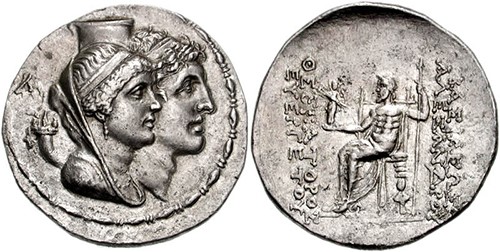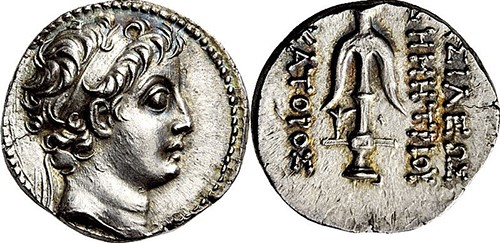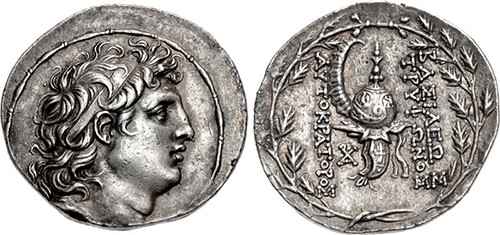NGC Ancients: Coins of the Seleucid Kingdom – Part 2
Posted on 10/10/2023
By
Ben Wallace
NGC Ancients Grader
In our previous column, we reviewed the history and coins of the early Seleucid Kingdom. This month, we’ll continue where we left off, with the execution of Antiochus V (164 to 162 B.C.) and the crowning of Demetrius I (162 to 150 B.C.).
Demetrius I was the son of an earlier king, Seleucus IV (187 to 175 B.C.), and had been sent to Rome as a political captive. After the death of Seleucus IV, the Romans refused to allow Demetrius I to seek the Seleucid throne. The Romans preferred to allow other weaker kings to exhaust themselves fighting over the vacant throne.
 |
Demetrius I eventually escaped the Romans and claimed his right to rule the Seleucid Kingdom. One of his first acts was to execute the interloper Antiochus V. Shown above is a silver tetradrachm with the diademed head of Demeterius I, opposite the seated goddess Tyche holding a baton and cornucopia.
The reign of Demetrius I was filled with conflict. The Romans were not happy to see the rightful king ruling and supported efforts to overthrow him. Demetrius I fought against many rebellions, including a revolt in Judaea. The fatal conflict against Demetrius I was started by Alexander I (152 to 145 B.C.), the supposed son of an earlier king.
After gaining power, Alexander I secured an alliance with Ptolemaic Egypt by marrying Cleopatra Thea (125 to 121 B.C.), the daughter of the reigning king, Ptolemy VI (180 to 145 B.C.). Eventually, Alexander I was challenged by Demetrius II (146/5 to 138 B.C.), the eldest son of Demetrius I, who staged a revolt. Initially, Ptolemy VI came to the aid of Alexander I, but in a surprising move switched sides and remarried his daughter to Demeterius II (and, later still, she married a third Seleucid king!).
Such absurd changes in alliances were par for the course in the Seleucid and Ptolemaic kingdoms. Alexander I was killed during the war.
 |
The rare and impressive silver tetradrachm above celebrates the first wedding of Cleopatra Thea, showing her with her husband Alexander I. The reverse shows the god Zeus holding Nike who in turn holds a tiny thunderbolt.
 |
Demetrius II was the only Seleucid king to reign twice. The silver drachm above, from his first reign, shows the diademed head of Demetrius II opposite an anchor with a small lily.
During his first reign, Demetrius II violently put down the supporters of Alexander I. This led to riots and rebellions which weakened his rule. Meanwhile, Demetrius II marched to the eastern reaches of his kingdom to reclaim land against the invading Parthians with initial success, but he eventually was captured by the Parthians and held as a political prisoner for almost a decade.
During the interim after his capture, others ruled. Next in line was Antiochus VI (144 to 142 B.C.), the young son of the former king Alexander I. He was placed on the throne as a puppet so the general Diodotus Tryphon could rule through him. Antiochus VI died a few years later under unknown circumstances, but perhaps under orders from Tryphon.
 |
The young puppet king Antiochus VI often is shown wearing a large radiate crown and a royal diadem, such as on the silver tetradrachm above. The reverse shows the Dioscuri on horseback within a wreath.
From this point onward, the Seleucid world was fractured among a number of claimants to the throne, with their fates and reigns overlapping.
 |
After the death of Antiochus VI, Diodotus Tryphon (c.142 to 138 B.C.) remined in power and issued his own coins, which ignore the traditional badges and types of the Seleucid Dynasty. The silver tetradrachm shown above has the well detailed bust of King Tryphon on the obverse and an elaborate Macedonian helmet adorned with a goat's horn on the reverse.
Tryphon did not rule long, however, for he was challenged by Antiochus VII (138 to 129 B.C.), the younger brother of Demetrius II, who eventually defeated and killed him.
 |
Antiochus VII, shown above on a silver tetradrachm, soon married his brother's wife, Cleopatra Thea, becoming her third husband. He focused on expanding the shrinking Seleucid Kingdom and found some success against the Parthians in the East.
In a desperate bid to stop Antiochus VII, the Parthians released their royal captive, the former Seleucid king Demetrius II, hoping this would sow discord. Before this happened, however, Antiochus VII was ambushed and killed during an uprising in some newly conquered land. He was the last Seleucid ruler to have any major success expanding the kingdom.
 |
Fortunately for Demetrius II, the Seleucid throne was vacant and he was able to regain power for a second time (129 to 125 B.C.) unopposed, though he remained unpopular with his subjects. Above is a silver tetradrachm from his second reign, no longer a child-king, but a grown man with a long beard reminiscent of those worn by the Parthian kings.
In a desperate gamble to gain influence in the Hellenistic East, Demetrius II involved himself in a dispute between two Ptolemaic rulers, Cleopatra II and Ptolemy VIII. He unfortunately sided with Cleopatra II, who lost the dynastic feud, causing Demetrius II to retreat in humiliation.
This gave rise to the revolt of Alexander II, a supposed son of the previous king Alexander I. Demetrius II fought a losing war, with even his own wife, Cleopatra Thea, closing the gates of Ptolemais on him. He was denied any further asylum, leading to his capture and death.
 |
It is believed the next king, Alexander II (128 to 122 B.C.), was not from the Seleucid royal line, but was the son of a Greek merchant. However, he portrayed himself as the son of Alexander I and defeated Demetrius II with the support of the victorious Egyptian king Ptolemy VIII.
He is portrayed on the extremely rare tetradrachm above, which shows on its reverse the god Sandan and a winged lion standing upon an altar. Sandan was an ancient Hittite god who was sometimes compared to Heracles.
Alexander II was a popular king with the people and continued to gain influence in the region. This gave rise to opposition, as was typical in this period. Ptolemy VIII feared the rising strength of the new Seleucid king and made an alliance with Cleopatra Thea, the royal Ptolemaic woman who previously had been married to three Seleucid kings.
She stepped forth with her son Antiochus VIII (121 to 96 B.C.) to wage war on the popular Alexander II, who they defeated and killed.
 |
Cleopatra Thea is one of the most interesting woman in history. Not only was she married to three Seleucid kings, but eventually she co-ruled with her son, Antiochus VIII. As her son matured, he became more difficult to control so she attempted to poison him. He guessed her intentions and forced her to drink the wine she’d offered, killing her.
Among the very rare coins of Cleopatra Thea is the exceedingly rare gold stater shown above. It was made to celebrate her marriage to Alexander I, just like the tetradrachm shown earlier. However, in this case she is portrayed alone. The two diademed cornucopias on the reverse harken back to her Ptolemaic roots.
 |
Our final coin for this month is a silver tetradrachm of Cleopatra Thea and Antiochus VIII. The obverse shows the jugate portraits of the royal mother and son, the reverse Zeus enthroned holding a Nike.
Next month we’ll finish our survey, picking up with the sole-reign of Antiochus VIII.
All images courtesy of Classical Numismatic Group.Stay Informed
Want news like this delivered to your inbox once a month? Subscribe to the free NGC eNewsletter today!
